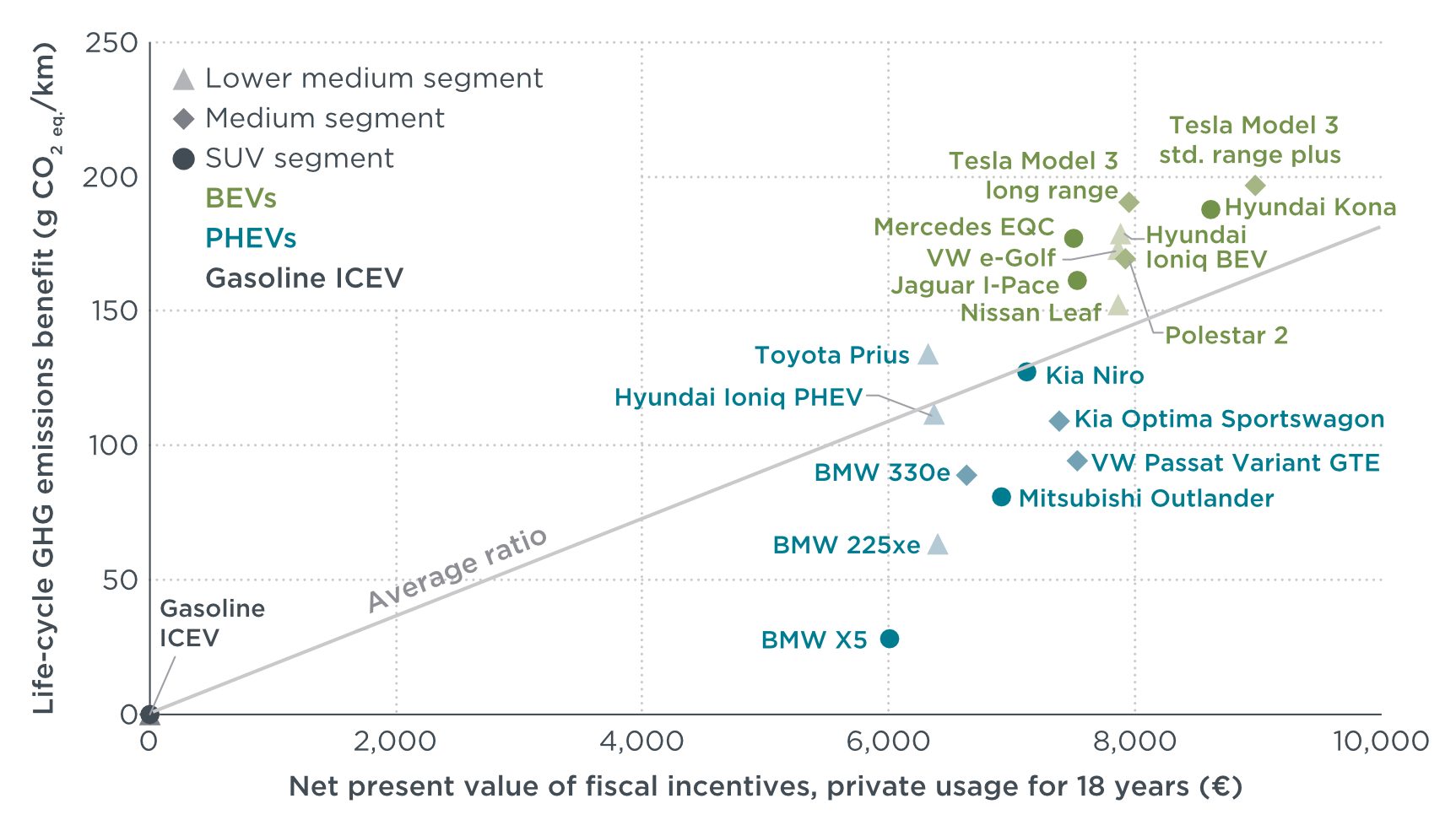Blog
Purchase premiums for plug-in hybrids in Germany: Within the EU’s CO2 standards, the subsidy does more harm than good for the climate
Effective climate policy requires a realistic assessment of greenhouse gas (GHG) emissions. Otherwise, policy measures may result in little climate benefit despite high costs. In the worst case, as with the purchase premiums for plug-in hybrids in Germany, generous government subsidies may even lead to a negative climate effect.
Since plug-in hybrids can run on gasoline or diesel as well as electricity, the CO2 emissions they cause depend on how often they are charged and driven on the electric motor. For the official type-approval values, it is assumed that plug-in hybrids are predominantly operated electrically. In reality, plug-in hybrids cover significantly more distance on fossil fuel than on electricity. On average, the fuel consumption —and thus also the CO2 emissions—of privately used plug-in hybrids in Germany is two to three times higher than the official values. For company cars, emissions are even four times as high on average.
Nevertheless, the German government is spending a lot of money to promote plug-in hybrids. The government’s share of the purchase premium (Innovationsprämie) for plug-in hybrids alone currently amounts to €3,750 to €4,500 per vehicle. In a recent study with the Fraunhofer Institute for Systems and Innovation Research (ISI), we further consider the incentives provided by the lower vehicle ownership tax rates. When comparing plug-in hybrid models with similar conventional gasoline vehicles over the entire lifetime of the vehicles, the total fiscal incentive for privately used plug-in hybrids already amounts to up to €7,500. If we consider that plug-in hybrid vehicles are typically used as company cars during the first two years and include the reduced company car tax for plug-in hybrids, the incentives for a single plug-in hybrid currently costs the German government a total of up to €11,400.
As shown in Figure 1, battery electric cars benefit from an even higher tax subsidy than plug-in hybrids. However, compared to gasoline-powered cars, battery electric cars also save twice as much emissions on average as plug-in hybrids. Depending on the vehicle model, the GHG emissions of battery electric vehicles are 57 to 67 percent lower than those of comparable gasoline vehicles. For plug-in hybrids, emissions are only about 34 percent lower than gasoline vehicles and vary widely (from 10 to 52 percent reduction). These values refer to emissions over the entire life cycle, i.e., including fuel and electricity production as well as battery and vehicle manufacturing.

Figure 1: Life-cycle GHG emissions benefit when compared to a segment average gasoline ICEV versus net present value of the fiscal incentives for the PHEV and BEV models in private usage in 2021 to 2038.
Comparing the cost of the fiscal incentives with the climate benefit compared to similar gasoline cars shows that the government share of the purchase premium for plug-in hybrids should be reduced by at least €2,500 to achieve a similar climate benefit to cost ratio as for battery electric vehicles. In addition, the company car tax for plug-in hybrids should be increased to the level levied on purely combustion vehicles.
However, these conclusions only apply when looking at the individual vehicle level and focusing solely on the German market. For the EU-wide new vehicle fleet, binding CO2 standards apply, which vehicle manufacturers must comply with. If plug-in hybrids become particularly attractive to customers in a Member State like Germany due to generous government subsidies, this will help vehicle manufacturers to reduce the average CO2 value of their fleet—at least on paper. In return, vehicle manufacturers can ultimately sell more high-emission vehicle models and still meet the CO2 fleet targets. In principle, the same effect results from the sale of battery electric cars. However, the difference in emissions between battery electric cars and internal combustion vehicles in the official CO2 figures is similar to the savings of life-cycle emissions in real world. So, a new battery electric car does offset the higher emissions of a new gasoline or diesel vehicle. For plug-in hybrids, however, the official CO2 savings turn out to be largely a sleight of hand. Looking at the entire fleet, emissions rise with every liter of fuel that plug-in hybrids consume in addition to the official values. According to estimates by the Federal Environment Agency, each newly registered plug-in hybrid corresponds to additional emissions of 10 to 15 metric tons of CO2. With this background, fiscal incentives for plug-in hybrids are therefore in most cases an environmentally harmful subsidy.
A quick correction of the unrealistic assumptions regarding the real use of plug-in hybrids in the European type-approval is currently not in sight. In order to achieve a demonstrably positive climate effect, as specified in the German government’s coalition agreement, the purchase premium for plug-in hybrids would not only have to be reduced by €2,500, but abolished altogether, as recently proposed by the German Federal Ministry of Economics and Climate Protection. Similarly, the reduction of the company car tax for plug-in hybrids would have to be phased out.
Alternatively, the purchase premium and reduced company car tax rates could be limited to those plug-in hybrid drivers who can demonstrate an average fuel consumption similar to the official values, which usually is around 2 liters per 100 km, in the first few years of vehicle use. Depending on the model, this corresponds to an electric driving share of 65 to 80 percent. An electric driving share of only 50 percent, as proposed in the coalition agreement, would be too low and does not take into account the different fuel efficiency of the various plug-in hybrid models. Depending on the model, it would thus still mean two to four times higher CO2 emissions. Only if fiscal incentives for plug-in hybrids are limited to those drivers who can demonstrate their fuel consumption is close to the official CO2 values, the promotion of plug-in hybrids would become a policy without a negative climate effect.
